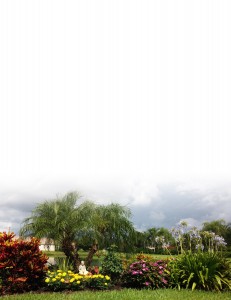“It’s an oasis!”…“I feel like I’m back in Costa Rica.”… “It reminds me of Hawaii.”…“Hydrangeas don’t bloom in Florida!”…“Your garden always makes me feel good.” Friends, strangers, and neighbors have made these comments walking past our garden. It began simply enough as a six-foot plot of earth with a Pygmy Palm in the middle of it. Then a family of sandhill cranes looking for grubs expanded it to eight feet. Their search for food compelled us to do something with the mound of now bare soil they’d overturned.
The teachings on Nature by Sufi mystic Inayat Khan came to mind. He said:
“There is only one holy book. It is the sacred manuscript of Nature and it is the only scripture that can enlighten the reader.” He went on, “All scriptures, before Nature’s manuscript, are just little pools of water before the ocean.”
His teachings on Nature blended easily with our own practices on Mindfulness. In that perfect alignment of being present in the moment “The Garden” came into being. It didn’t come with instructions on what to plant. So we just sat with it intuitively. Using mindfulness techniques we were present to every nuance it revealed. We felt the warm humid atmosphere in and around the area. It was a vibrant place filled with insects and birds. Digging into the soil, we saw tan-colored dry sand and black moist clay battle for dominance. Mindful tilling uncovered earthworms everywhere, and they were helping to aerate the soil with long trenches. Sadly, they also fed the white Ibises that arrived in flocks every morning at dawn. A few earthworms usually escaped the long curved bills that probed deep inside their trenches. It was Nature teaching about life.
Days settled into weeks, and then months, as we prepared the planting bed. We planted by season, consciously watching the direction of the sun’s angle to the garden. We saw how its progression across the sky brilliantly lit the garden or where it left shadows from the palm. The sun guided which plants would work best. But it was the flowers that told us what to do.
We were present to each one in its growing season, selecting glorious shrubs and annuals in a riot of colors.
We spent our days digging, spading, fertilizing, watering, and pruning. We talked to the plants if they were stressed, assuring them all was well. We praised the ones that produced the most brilliant blossoms, telling them how remarkable they were. When experts assured us we couldn’t grow roses in the heat of Florida, we shrugged pointing to the pink, yellow, or red long-stemmed beauties. “Tell them!” we said.
Every morning we made a daily pilgrimage into the garden. We admired each plant, propping up some dirt around the base of one, removing a twig that had fallen on a flower, or cutting off a dead branch. We touched their leaves in silent homage. We hovered over a new seedling like expectant mothers. We showered gratitude and appreciation for all of their unique expressions. In time we came to realize working the garden had become its own form of meditation—a most natural and easy form of direct communication with Nature.
Inayat Khan said every leaf is a page that contains divine revelation.
In the 10 seasons as caretakers of the garden, it has taught us how to read the manuscript of Nature.
The manuscript showed there was a cycle of birth, growth, and death in every entity. While plants do grow tall and burst with flowers, soon those flowers die, their seeds feeding the birds. But always, life continues. Some seeds that fall to the ground become seedlings. In time, those seedlings become mature plants with new flowers, repeating the cycle of birth, growth, and death. The plants were no different than the sandhill cranes that returned every spring, laid eggs, hatched their babies, and taught them how to feed on grubs and earthworms, often in our garden.
Nature is a fully balanced organism. It doesn’t really need humans. But humans need it.
It transports us to a place outside ourselves. It gives us the space to slow down and to appreciate the magnificent colors and scents that can alter our moods. It teaches us about birth, life, and death. It allows us the freedom to become at peace with this knowledge. And it bestows its bounty on those who take the time to let it do so. The garden is a “Harvest of Presence.” All one must do is practice being in the present moment and having patience—and then listen.
Jo Mooy has studied with many spiritual traditions over the past 40 years. The wide diversity of this training allows her to develop spiritual seminars and retreats that explore inspirational concepts, give purpose and guidance to students, and present esoteric teachings in an understandable manner. Along with Patricia Cockerill, she has guided the Women’s Meditation Circle since January 2006 where it has been honored for five years in a row as the “Favorite Meditation” group in Sarasota, FL, by Natural Awakenings Magazine. Teaching and using Sound as a retreat healing practice, Jo was certified as a Sound Healer through Jonathan Goldman’s Sound Healing Association. She writes and publishes a monthly internationally distributed e-newsletter called Spiritual Connections and is a staff writer for Spirit of Maat magazine in Sedona. For more information go to www.starsoundings.com or email jomooy@gmail.com.

